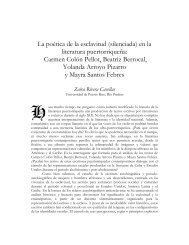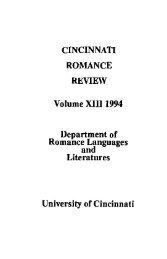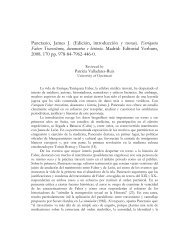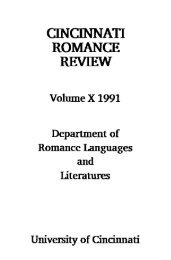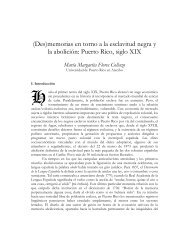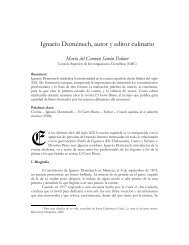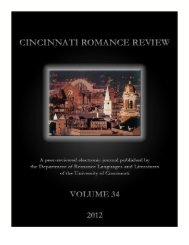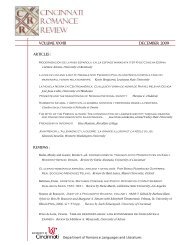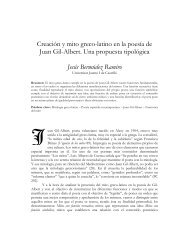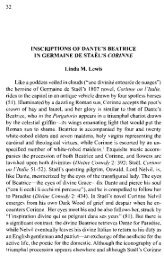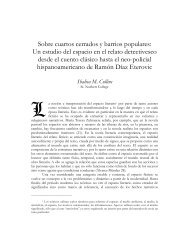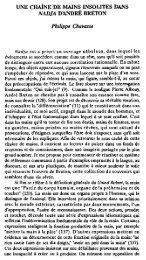Volume 30 (2011) - Cincinnati Romance Review
Volume 30 (2011) - Cincinnati Romance Review
Volume 30 (2011) - Cincinnati Romance Review
Create successful ePaper yourself
Turn your PDF publications into a flip-book with our unique Google optimized e-Paper software.
“DOUBLE CONSCIOUSNESS/DOUBLE BIND” 81<br />
At the turn of the twentieth century, afra-Hispanic writers struggled to deal<br />
simultaneously with issues of gender and race. Carmen Colón Pellot and Julia de Burgos<br />
negotiated the dual heritage of being Hispanic and African –a duality which is<br />
complicated by both their gender and ethnicity in a male dominated literary world. Their<br />
poetry remains important because it transformed a white male centered patriarchal<br />
discourse by converting the black female object into a subject who contributed to the<br />
social and cultural milieu. The problematic of race and gender is not only evidenced in<br />
the writings of Colón Pellot and de Burgos; this is a common issue in Afra-Hispanic<br />
texts and affects our reading of their works. The reasons are manifold and have as<br />
much to do with perceptions of feminism in Latin America as to the guilt that many<br />
African Diaspora women experience when discussing their gender; many believe that<br />
they do so at the expense of their race. In many ways, their works foreshadow the<br />
writings of Afra-Cuban poet Nancy Morejón who in 1975 wrote “Mujer negra”, a poem<br />
as the title suggests that incorporates the African female experience into the narrative of<br />
the history of the Americas illustrating the possibility to write both as a woman and as a<br />
black.<br />
WORKS CITED<br />
Boyce Davies, Carole. Black Women, Writing and Identity: Migrations of the Subject. New<br />
York: Routledge, 1994. Print.<br />
Burgos, Julia de. Song of the Simple Truth: The Complete Poems of Julia de Burgos.<br />
Willimantic, CT: Curbstone Press, 1997. Print.<br />
Cartey, Wilfred G. Black Images. New York: Teachers College Press, 1970. Print.<br />
Castillo, Debra A. Talking Back: Toward a Latin American Feminist Literary Criticism.<br />
Ithaca and London: Cornell University Press, 1992. Print.<br />
Colón Pellot, Carmen. Ámbar mulato. Arecibo, Puerto Rico, 1938. Print.<br />
DeCosta-Willis, Miriam. “Introduction: ‘This Voyage Toward Words’: Mapping the<br />
Routes of the Writers.” Daughters of the Diaspora. Ed. Miriam DeCosta-Willis.<br />
Kingston, Miami: Randle Press, 2003. xvi-xlii. Print.<br />
Du Bois, W.E.B. The Souls of Black Folk. 1903. New York: Penguin Books, 1989. Print.<br />
Esteves, Carmen. “Julia de Burgos: Woman, Poet, Legend.” A Dream of Light and<br />
Shadow: Portraits of Latin American Women Writers. Albuquerque: University of<br />
New Mexico, Press, 1995. Print.<br />
Feal, Rosemary. “Feminism and Afro-Hispanism: The Double Bind.” Afro-Hispanic<br />
<strong>Review</strong> (2002): <strong>30</strong>-34. Print.<br />
Guillén, Nicolás. “Balada de los dos abuelos.” Afro-Hispanic Literature: An Anthology of<br />
Hispanic Writers of Hispanic Ancestry. Ed. Ingrid Watson-Miller. Miami, Florida:<br />
Colección Ébano y Canela, 1991.55-56. Print.<br />
<strong>Cincinnati</strong> <strong>Romance</strong> <strong>Review</strong> <strong>30</strong> (Winter <strong>2011</strong>): 69-82.



